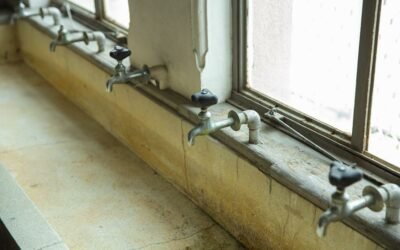Are you tackling a mold removal project and want to ensure your safety? Look no further! We've got you covered with the best respirators available.
Whether you're dealing with minor mold issues or more severe contamination, we'll help you find the perfect respirator. From N95 and P100 respirators to half and full face options, as well as powered air purifying respirators (PAPR), we'll guide you through the top choices for effective mold removal.
Stay protected and breathe easy with our expert recommendations.
Key Takeaways
- N95 respirators are designed to filter out airborne particles, including mold spores, and can filter out at least 95% of airborne particles.
- P100 respirators offer superior filtration capabilities compared to N95 respirators, filtering out at least 99.97% of airborne particles, including mold spores.
- Full face respirators provide complete protection by shielding the entire face from mold spores, with a secure seal and integrated face shield for enhanced protection.
- Full face respirators are recommended for individuals with respiratory sensitivities or working in high-risk environments, as they allow for comfortable breathing and better visibility.
N95 Respirators
When removing mold, it is important to protect yourself by wearing an N95 respirator. This type of respirator is specifically designed to filter out airborne particles, including mold spores, that may pose a risk to your health. The 'N95' designation means that the respirator can filter out at least 95% of airborne particles, making it highly effective in preventing inhalation of mold spores.
N95 respirators are made of multiple layers of synthetic material that capture and trap particles as you breathe. They have a snug fit, thanks to their adjustable nose piece and elastic straps, ensuring that no unfiltered air enters through the edges. It's important to note that N95 respirators are disposable and should be discarded after each use or if they become damaged or soiled.
When using an N95 respirator for mold removal, it's crucial to follow proper donning and doffing procedures. Before putting on the respirator, make sure your hands are clean and free of any contaminants. Place the respirator over your nose and mouth, adjusting the nose piece to fit securely. Secure the elastic straps around your head and perform a fit check to ensure a proper seal. To remove the respirator, avoid touching the front of it and use the straps to carefully remove it without touching your face.
P100 Respirators
To further protect yourself during mold removal, consider using P100 respirators, which offer even greater filtration capabilities than N95 respirators. P100 respirators are designed to filter out at least 99.97% of airborne particles, including mold spores.
Here are three key reasons why P100 respirators are the best choice for mold removal:
- Superior Filtration: P100 respirators use a highly efficient filter media that can capture particles as small as 0.3 microns. This means they can effectively trap mold spores, which are typically between 1 and 100 microns in size.
- Full Face Coverage: P100 respirators come with a full facepiece, providing comprehensive protection for your eyes, nose, and mouth. This is crucial when dealing with mold, as it can cause respiratory irritation and allergic reactions if inhaled or comes into contact with your skin.
- Reusable and Durable: P100 respirators are designed to be reusable and can last for a long time with proper maintenance. This makes them a cost-effective choice for regular mold removal tasks.
When choosing a P100 respirator, make sure it fits properly and creates a secure seal against your face. Remember to follow the manufacturer's instructions for maintenance and replacement of filters to ensure maximum effectiveness.
Half Face Respirators
If you're looking for a reliable option for mold removal, consider using half face respirators. These respirators cover the nose and mouth, providing protection against mold spores and other airborne contaminants. They're a popular choice among professionals in the mold remediation industry.
Half face respirators feature a comfortable and secure fit, thanks to adjustable straps and a tight seal around the face. This prevents any mold spores from entering the user's respiratory system. They're also lightweight and easy to wear for extended periods, making them ideal for long hours of mold removal work.
When choosing a half face respirator for mold removal, look for models that are specifically designed for this purpose. These respirators should be equipped with replaceable filters that are capable of filtering out mold spores and other particulates. The filters should have a high efficiency rating, such as N95 or P100, to ensure maximum protection.
It is important to note that half face respirators only cover the nose and mouth, leaving the eyes exposed. To protect your eyes from mold spores, it's recommended to wear safety goggles or a full-face respirator with an integrated face shield.
Full Face Respirators
If you want complete protection during mold removal, consider using full face respirators. These respirators offer superior coverage and shield your entire face from harmful mold spores and other contaminants. They're especially recommended for individuals with respiratory sensitivities or those working in high-risk mold removal environments.
Here are three key advantages of using full face respirators:
- Enhanced Protection: Full face respirators provide a secure seal around your face, preventing any mold spores from entering your respiratory system. The integrated face shield protects your eyes, preventing irritation or injury caused by airborne particles.
- Comfort and Convenience: With a full face respirator, you can breathe comfortably while working on mold removal tasks. The wide field of vision allows for better visibility, ensuring that you can see clearly and work efficiently. Additionally, the adjustable straps and lightweight design make the respirator comfortable to wear for extended periods.
- Versatility: Full face respirators can be used not only for mold removal but also for a range of other tasks, such as painting, woodworking, and chemical handling. They provide comprehensive protection against various airborne hazards, making them a versatile choice for different applications.
Powered Air Purifying Respirators (PAPR)
When using full face respirators for mold removal, you can further enhance your protection by considering Powered Air Purifying Respirators (PAPR). PAPRs are a type of respiratory protection that use a battery-powered blower to deliver filtered air to the user's breathing zone. They're designed to provide a higher level of protection compared to traditional respirators, as they actively filter and supply clean air, reducing the wearer's exposure to airborne contaminants.
PAPRs consist of a headpiece that covers the entire face, a breathing tube, and a blower unit that can be worn on a belt or carried on the user's back. The blower unit draws air through filters and delivers it to the headpiece, creating a positive pressure environment inside the respirator. This positive pressure helps to prevent contaminated air from entering the respirator through any gaps or leaks.
One of the advantages of PAPRs is that they provide a constant and uninterrupted supply of filtered air, ensuring that the wearer always has a sufficient amount of clean air to breathe. This is particularly beneficial in situations where the concentration of mold spores or other contaminants is high.
PAPRs also offer a higher level of comfort compared to other respirators, as they don't rely on a tight seal against the face. This can be especially advantageous during extended periods of use, as it reduces the risk of fatigue and discomfort.
Conclusion
In conclusion, when it comes to choosing the best respirator for mold removal, it's important to consider the level of protection required.
N95 respirators are suitable for most mold removal tasks, while P100 respirators offer higher filtration efficiency.
Half face respirators provide adequate protection for small-scale projects, while full face respirators offer complete face coverage.
For more advanced protection, powered air purifying respirators (PAPR) can be used.
Ultimately, selecting the right respirator will ensure safety and effectiveness during mold removal procedures.






0 Comments